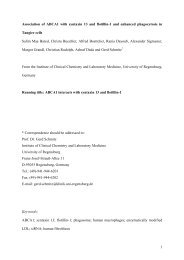SUNDAY, DECEMBER 4- Late Abstracts 1 - Molecular Biology of the ...
SUNDAY, DECEMBER 4- Late Abstracts 1 - Molecular Biology of the ...
SUNDAY, DECEMBER 4- Late Abstracts 1 - Molecular Biology of the ...
You also want an ePaper? Increase the reach of your titles
YUMPU automatically turns print PDFs into web optimized ePapers that Google loves.
1999<br />
P7BP1 E3 ubiquitin ligase controls <strong>the</strong> quality <strong>of</strong> PTS2 receptor, Pex7p.<br />
Y. Miyauchi 1 , Y. Fujiki 1 ; 1 Kyushu University, Fukuoka, Japan<br />
<strong>SUNDAY</strong><br />
Peroxisomes are ubiquitous single membrane-bound organelles that contain about 100 different<br />
enzymes catalyzing various metabolic pathways such as fatty-acid ƒÀ-oxidation and<br />
e<strong>the</strong>rglycerolipid syn<strong>the</strong>sis. Peroxisomes are formed by growth and division <strong>of</strong> preexisting<br />
peroxisomes after posttranslational import <strong>of</strong> newly syn<strong>the</strong>sized peroxisomal matrix and<br />
membrane proteins. Two distinct signals, peroxisomal targeting signal type 1 (PTS1) and PTS2,<br />
direct proteins to <strong>the</strong> peroxisomal matrix. PEX5 and PEX7 encode <strong>the</strong> cytosolic receptors for<br />
PTS1 and PTS2, respectively. Mono-Ubiquitination <strong>of</strong> Pex5p is required for its export from<br />
peroxisomal membrane to <strong>the</strong> cytosol in yeast to mammals. However, regulation <strong>of</strong> <strong>the</strong> function<br />
and transport <strong>of</strong> Pex7p remains undefined.<br />
We first investigated whe<strong>the</strong>r or not Pex7p is ubiquitinated and degraded by proteasomes in<br />
cells. Addition <strong>of</strong> a proteasome inhibitor, MG132 to cell culture delayed <strong>the</strong> turnover rate <strong>of</strong><br />
Pex7p. We also attempted to isolate any potential Pex7p-binding proteins potentially involved in<br />
<strong>the</strong> degradation pathway <strong>of</strong> Pex7p. From a cell line stably expressing FLAG-Pex7p, we isolated<br />
several Pex7p-binding proteins, termed P7BPs: Pex7p binding proteins. Suppression <strong>of</strong> P7BP1<br />
by RNAi resulted in a delay <strong>of</strong> Pex7p turnover rate, as observed in <strong>the</strong> MG132-treated cells,<br />
hence implying that P7BP1 plays a role in Pex7p ubiquitination. Fur<strong>the</strong>rmore, we also show that<br />
<strong>the</strong> degradation <strong>of</strong> dysfunctional Pex7p mediated by P7BP1 is crucially required for <strong>the</strong><br />
maintenance <strong>of</strong> normal PTS2 import. Our findings may define a mechanism underlying Pex7p<br />
degradation and its importance in regulating PTS2 import.<br />
2000<br />
A System to Quantify <strong>the</strong> Differential Import <strong>of</strong> Peroxisomal Matrix Protein by Measuring<br />
Fluorescence Intensity.<br />
M. Noguchi 1 , Y. Fujiki 1,2 ; 1 Graduate School <strong>of</strong> Systems Life Sciences, Kyushu University,<br />
Fukuoka, Japan, 2 CREST, JST<br />
Fourteen distinct peroxins are identified as essential factors for peroxisome biogenesis in<br />
mammals, <strong>of</strong> which ten are involved in peroxisomal import <strong>of</strong> matrix proteins. Peroxisomal<br />
matrix protein import is regulated by various cellular factors. However, mechanisms underlying<br />
such regulations are poorly understood, partly, if not all, due to <strong>the</strong> lack <strong>of</strong> quantitative detection<br />
method with high resolution. Here, we developed a monitoring system that utilizes <strong>the</strong><br />
differences in <strong>the</strong> stability <strong>of</strong> fluorescent reporters localized between peroxisomes and <strong>the</strong><br />
cytosol. An FKBP12 variant, termed destruction domain (DD), is rapidly and constitutively<br />
degraded by proteasomes when expressed in mammalian cells. Degradation <strong>of</strong> DD is reversibly<br />
protected by addition <strong>of</strong> a specific syn<strong>the</strong>tic ligand. In <strong>the</strong> absence <strong>of</strong> <strong>the</strong> ligand, a reporter DD-<br />
EGFP-PTS1, EGFP fused with <strong>the</strong> DD and peroxisomal targeting signal 1, is largely degraded<br />
in <strong>the</strong> cytosol prior to entering peroxisomes in wild-type cells. In contrast, in <strong>the</strong> presence <strong>of</strong> <strong>the</strong><br />
ligand <strong>the</strong> reporter becomes stable and translocates into peroxisomes. Upon withdrawal <strong>of</strong> <strong>the</strong><br />
ligand, <strong>the</strong> reporter in peroxisomes remains intact, whilst that in <strong>the</strong> cytosol is rapidly degraded.<br />
Thus, peroxisomal protein import can be readily quantified by simply measuring <strong>the</strong><br />
fluorescence intensity <strong>of</strong> whole cells.
















